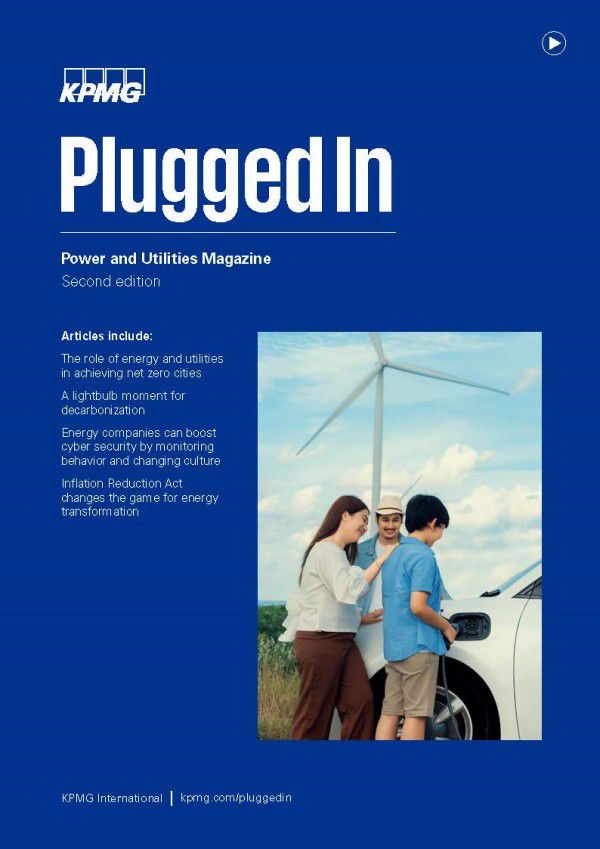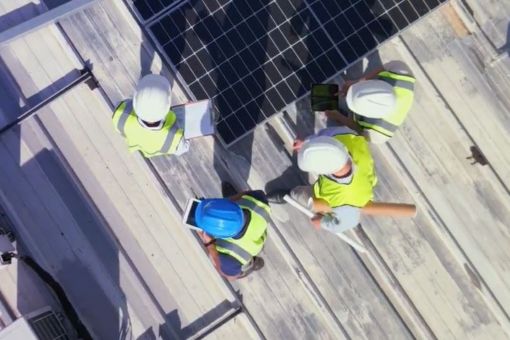A look at the energy-related tax provisions
Following many months of negotiation between branches of the United States government, on 16 August 2022, President Joe Biden signed the Inflation Reduction Act (IRA) into law. Although, as the name suggests, it includes measures that aim to reduce inflation, it also contains a significant package of tax incentives and benefits designed to support the US in tackling climate change. These cover how it produces energy and other measures, such as encouraging decarbonization through carbon capture and promoting the use of electric vehicles. In September, President Biden described the IRA as “the most aggressive action ever… to confront the climate crisis and increase our energy security.” 1
The Act’s energy industry measures are numerous and, in several cases, innovative, with new mechanisms that allow tax credits to be sold to unrelated third parties or settled through direct payments from the government. Some tax incentives are linked to the location of projects and suppliers, workers’ pay and the development of apprenticeship programs. This article will focus on a small number of tax changes that create opportunities and challenges for energy companies with US operations.
New ‘direct pay’ tax credits for hydrogen, CCS and advanced manufacturing production
The IRA provides specific support for producing clean hydrogen and carbon capture and sequestration (CCS) through new ‘direct pay’ tax credits. These are settled directly by the federal government, allowing users to obtain a refund of any credit amount above tax liability for a five-year period. Alternatively, the credits can be sold to unrelated third parties.
The size of these credits can vary significantly based on several factors, including how efficient energy technologies reduce greenhouse gas emissions. For example, the full base credit is available only for clean hydrogen processes that generate less than 0.45 kilograms of carbon dioxide equivalent greenhouse gases (CO2e) for each kilogram of hydrogen. Those in the next range, which generate 0.45 to 1.5 kilograms of CO2e, are eligible for just a third of this credit.2 Other factors that aim to support local economies and workers across the US, discussed below, will also have significant impacts on a project’s tax credits.
Refundable and transferable direct pay tax credits look highly attractive. Their introduction will likely lead to growing investment in these areas, including from overseas, helping energy companies seeking financing for such projects. There may also be secondary benefits, as increasing numbers of smaller energy production sites will require more investment in transmission grid infrastructure to support their energy distribution.
But there are challenges, given the innovative nature and complexity of these new tax credits. Third parties purchasing them will be taking risks, meaning they will need to undertake due diligence and may need to buy insurance. The risks involved mean that tax credits will trade at a discount although the size of the discount rate is currently highly variable. Moreover, many questions remain regarding the market’s liquidity for trading credits, and potential participants are proceeding cautiously. The Internal Revenue Service has yet to publish details of how transferability and the direct pay of tax credits will be administered, with fuller guidance expected later this year.
Under existing law, to qualify for the investment and production tax credits, construction of energy generation facilities would have to start by the end of 2024. As defined by an annually published government table, all technologies producing zero or negative greenhouse gas levels will be eligible for these new technology-neutral credits beginning in 2025. The phaseout of these credits will begin at the earliest in 2034 or two years after the government determines that US electricity production will emit less than one-quarter of the greenhouse gases from 2022.

Plugged In
The role of energy organizations in combating climate change
Download magazine (2.46 MB) ⤓
Buy American, support localities
Many of the measures in the IRA also include increased credit rates designed to boost the US economy and its workforce, as well as specific local economies affected by the energy transformation. Specifically, the domestic content increase incentivizes the production of energy components nationally, requiring projects to be composed of certain levels of American-made components. The measures covering workers are also national in scope, although partly based on local conditions. In general, to qualify for the highest ‘bonus’ credit rate, projects beginning construction in 2024 will be required to use apprentices for at least 15 percent of total hours of employment, up from 12.5 percent in 2023.3 They will also have to pay ‘prevailing wages’, an existing set of pay levels published by the Department of Labor on the average salary of similarly-employed workers in a locality. These requirements have not previously been used to determine tax credits.
The most localized incentives are extra credits for facilities placed in what the Act calls an ‘energy community.’ These locations include brownfield sites, areas that have or have had certain levels of employment or local tax revenue from fossil fuels and above-average unemployment, or areas that have seen a coal mine close after 1999 or a coal-fired power plant shut down after 2009.
The incentives for domestic production are likely to mean more manufacturing in the US. This should help US-based energy utilities by shortening supply chains and making the delivery of equipment such as solar panels more reliable and quicker. But compliance is likely to be a key challenge in meeting the apprenticeship and prevailing wages requirements, with the latter requiring companies to have access to pay rates used by contractors and other third parties working on projects.
International impact
The IRA looks set to make the US, at present the world’s second-largest emitter of greenhouse gases, into a global leader in tackling climate change. However, by offering incentives for producing goods and minerals either domestically or by countries with a free-trade agreement, the legislation also looks likely to impact international providers of products required to decarbonize energy production worldwide.
In many respects, the IRA creates direct competition between China and the US, including for goods required by power utilities. It provides tax incentives for the American production of power storage batteries, wind turbines, solar panels and geothermal heat pumps, and the mining of lithium and nickel used in some of these. China is currently the world’s biggest manufacturer of these products and dominates battery and associated mineral supply chains.4 Despite the IRA, it seems likely that the global supply chains for renewable energy generation and batteries will run through China for some time, and utilities should watch to see how China’s government reacts to US legislation
As a result of the demands EVs put on grids, there may be an impact on the production of electric vehicles (EVs). According to the Act, final assembly must happen in North America, and 50 percent of EV batteries and battery content must come from the US or a free-trade partner by 2028. These partners include Australia and Canada but exclude major vehicle manufacturers such as France, Germany, Japan and the United Kingdom. Some of these countries have viewed the Act as an attempt to shift EV production from other countries to the US. However, the US government is willing to work to resolve this issue, with European and American officials meeting in December to discuss an agreement on the measures.
Other countries look set to benefit from the IRA. The Mineral Council of Australia believes the country’s lithium, copper, cobalt and nickel miners have a significant opportunity to support the US in moving to clean energy, given Australia’s free-trade agreement with the US. However, the Act’s incentives could only divert capital away from Australia’s efforts to develop its green hydrogen industry if its government introduces policies that support continued investment
The EU’s Carbon Border Adjustment Mechanism
The European Union (EU) has dedicated itself to sustainable development and has set a very ambitious target of becoming the first climate-neutral continent by 2050. One of the milestone targets towards this goal is the introduction of an EU Carbon Border Adjustment Mechanism (CBAM), which will come into effect on 1 October 2023. CBAM will operate by imposing a charge on the embedded carbon content of certain imports. This is equal to the charge imposed on the production of domestic goods under the EU Emissions Trading System, with adjustments being made to this charge to consider any mandatory carbon prices in the exporting country.
In the early stages of CBAM's implementation, the most affected industries will be those with high carbon intensity, such as the energy industry. Among the immediate, direct impacts are the possible increase in import prices for covered products, such as electricity and hydrogen. In addition, there is an increase in secondary goods that contain components of these products. Vehicle manufacturers, for example, may purchase fuel cells for electric vehicles containing higher-priced hydrogen imported from abroad. Upon importation, organizations must provide this product-specific information and the authorized declaration. A non-EU company will also be required to implement carbon accounting to track embedded emissions associated with these products and to have them independently verified if they wish to sell products covered by CBAM to the EU.
The energy industry value chain is very complex, interlinked and diverse. Its products are used in and supplied to all sectors of the economy. As CBAM is applied to this industry, its effects will be felt in other sectors and industries as well. There will be a direct impact on energy companies' supply and value chain, resulting in higher costs and increased pressures on the industry.
How can KPMG help
KPMG firms can assist companies in navigating the new rules in various ways. In addition to providing technical analysis and modelling to evaluate the comparative benefits of new credit programs, KPMG professionals are assisting with considerations surrounding new provisions and options, such as transferability, as well as documenting and managing apprenticeships and prevailing wage requirements.
The EU’s Carbon Border Adjustment Mechanism
The European Union (EU) has dedicated itself to sustainable development and has set a very ambitious target of becoming the first climate-neutral continent by 2050. One of the milestone targets towards this goal is the introduction of an EU Carbon Border Adjustment Mechanism (CBAM), which will come into effect on 1 October 2023. CBAM will operate by imposing a charge on the embedded carbon content of certain imports. This is equal to the charge imposed on the production of domestic goods under the EU Emissions Trading System, with adjustments being made to this charge to consider any mandatory carbon price effectively paid in the country of origin that is recognized by the EU, and free allowances provided under the EU ETS to facilities producing competing goods.
In the early stages of CBAM's implementation, the most affected industries will be those with high carbon intensity, such as the energy industry. Among the immediate, direct impacts are the possible increase in import prices for covered products, such as electricity and hydrogen. In addition, there may be an increase in secondary goods that contain components of these products. Vehicle manufacturers, for example, may purchase fuel cells for electric vehicles containing higher-priced hydrogen imported from abroad. Upon importation, EU organizations are required, from 1 October 2023, to fulfill reporting obligations and from 1 January 2026, to register as authorized declarants and start purchasing CBAM certificates. A non-EU company will be required to provide product-specific embedded emissions information and, from 1 January 2026, have the embedded emissions data verified by an independent, accredited verifier if they wish to sell products covered by CBAM to the EU.
The energy industry value chain is very complex, interlinked and diverse. Its products are used in and supplied to all sectors of the economy. As CBAM is applied to this industry, its effects will be felt in other sectors and industries as well. There will be a direct impact on energy companies' supply and value chain, resulting in higher costs and increased pressures on the industry.
Climate Policy Advisory
In these rapidly changing global environments, KPMG has a worldwide network of professionals that assist companies with understanding policy evolution in destination countries and optimizing business and ESG strategies. KPMG firms can assist your business in understanding the evolving climate-related regulatory landscape, including incentive measures and helping companies understand the risks and opportunities of such changes.
Additional thinking
Get in touch

Global Energy Institute
Receive valuable insights covering critical energy topics.

Follow us on LinkedIn
View regular energy content on our LinkedIn showcase page
Connect with us
- Find office locations kpmg.findOfficeLocations
- kpmg.emailUs
- Social media @ KPMG kpmg.socialMedia









